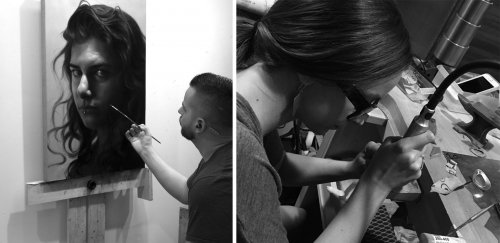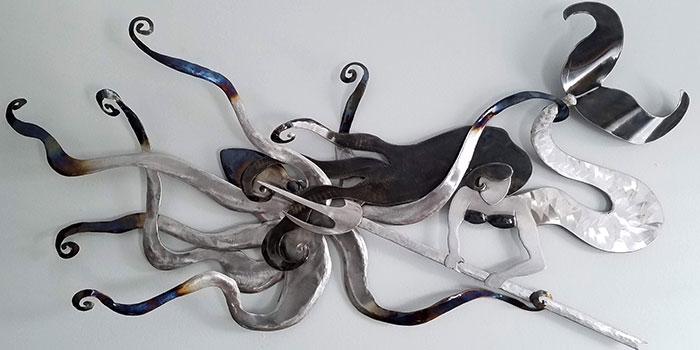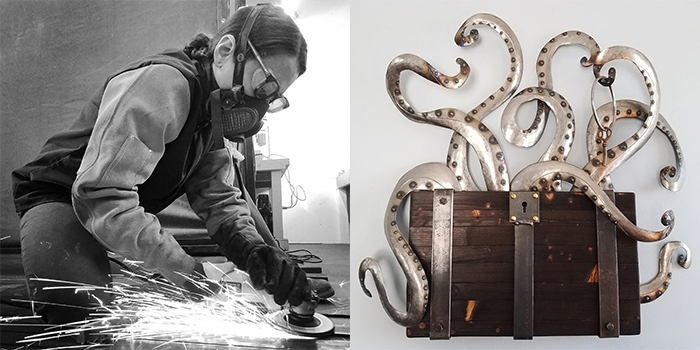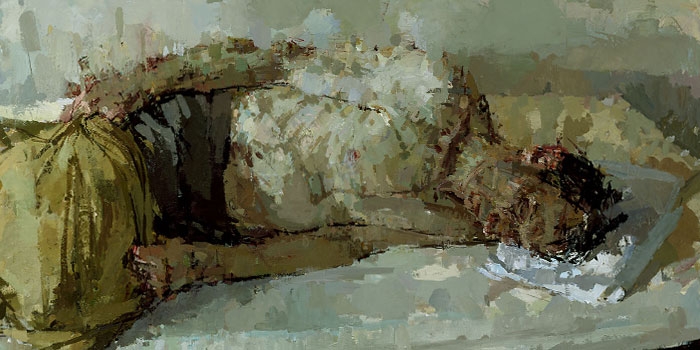
One of the most widely held clichés in the art world is that if you're an artist, the probability's high that you're going to starve.
Rhode Island College Professors of Art Douglas Bosch and Richard Whitten say talented artists can survive if they approach artmaking as a business.
Bosch and Whitten are professional artists themselves – Bosch, a sculptor, and Whitten, a painter. They also both teach ART 400: Issues for the Studio Artist, alternating years. Required of all B.F.A. majors, this course teaches students from all art disciplines how to survive at their craft.
Bosch and Whitten's answer to survival may surprise you. To be successful, they said, an artist needs to be able to write and speak clearly, concisely, confidently and persuasively because self-promotion via writing and word of mouth gets others interested in promoting you as well. If you're unintelligible on paper and in person you've lost your audience and possible patrons.

To refine their writing skills, Whitten's students are required to write a grant proposal, which includes a project description, line-by-line budget and artist statement; while Bosch's students can write either a grant proposal, artist residency application, graduate school application or exhibition proposal to a gallery or museum. However, every student will leave ART 400 with a solid résumé and artist statement, which all of these forms of funding or education require.
But will this help an artist sell their work?
"We don't teach students how to sell their work," said Whitten. "We teach them how to connect to gallery directors, grant agencies and residency boards" who invest in artists, Bosch said.
"Think about it this way," said Whitten. "There are so many great artists that a gallery could work with. In New York, art galleries get about 20 to 30 unwanted applications a day. It's the rare artist whose exhibition proposal is looked at. Most of the time it goes straight into the garbage. Taking on an artist is like getting married. Good writing will tell if the marriage is going to work."
"And all the gallery directors know each other," Bosch said. "They all know the curators. They all have friends in the various grant agencies. So, whatever reputation you have with any one of them will telegraph through the whole business."

Oral presentations are also required in ART 400, which can be particularly difficult for studio art majors. "I've seen students come close to tears during their presentation," Whitten said.
"But if they don't learn to put themselves out there and talk about their work, they're going to struggle through their own art opening," said Bosch.
"Which I've seen," Whitten said. "I've seen artists clam up completely and lose important opportunities."
Success is not just about talent, stressed Bosch and Whitten, it's about connecting with people.
For instance RIC alum and painter Nick Gebhart '13 met famous painter, sculptor and printmaker Eric Fischl at a group critique Fischl was hosting in New York City. During the group critique, Fischl spoke very highly of Gebhart's painting. Afterward, the two exchanged emails and kept in touch. In 2018 Fischl included one of Gehbart's paintings in a show he curated called "About Face" in South Hampton, New York.
That's one of many opportunities Gebhart has had along the way that evolved from communicating with potential supporters of his work.
RIC students get experience replicating these types of encounters via their B.F.A. Review, where they discuss their work with art faculty who are not their advisors and at the annual Senior Art Exhibition, where they display the projects they've been working on throughout the year with the campus community.

Every discipline is represented in the Senior Art Exhibition – ceramics, digital media, graphic design, metalsmithing and jewelry, painting, photography, printmaking and sculpture.
Dianne Reilly, professor of metalsmithing and jewelry, explained, "The entire process is meant to teach students what it takes to build a body of work, present their work in public and talk about their work in a way that's intelligible."
If Reilly's metalsmithing and jewelry art students decide not to open their own design studio and create their own line of jewelry, they often work for a company. One way to enter the industry is to apply to the prestigious New England Chapter of the International Precious Metals Institute's Jewelry Design Competition, an annual event that allows winners of the competition to network with potential employers. Today, some of her former students work for companies like Tiffany & Co. and H&D Crystal Manufacture.
Reilly's hope is that her students have a career making work that they enjoy and are passionate about.
"I worked for a silversmith who would often say, 'As long as I can put a bottle of wine and a loaf of bread on the table, I'm happy.' He wasn't looking to become wealthy off his art," said Reilly, "he just wanted to make enough money to pay his bills and enjoy his life."
"Surviving can be comfortable," added Whitten. "Success is surviving to do your art another day."
Some of RIC's Successful Art Alumni

Nick Gebhart is a realistic oil painter who lives and works in Brooklyn, New York. He earned a B.F.A. in painting at RIC in 2013 and an M.F.A. in painting at the New York Academy of Art in 2015. For the past four years, he has exhibited his work in New York and Rhode Island art galleries. He is also the recipient of numerous awards, including the 2019 Award of Excellence by Fine Art Connoisseur. Currently Gebhart works as painter assistant for renowned artist Ran Ortner. He has also worked for such prominent artists as Jeff Koons, Roy Nachum, Zaria Forman and Nir Hod.

Rachel Paolino earned her B.F.A. in sculpture with focus on metal fabrication in 2006. After graduating from RIC, she made a living through welding, photography and as a sales rep for Stonewood Products, where she took on side projects for the contractors and designers she’d meet. Eventually Paolino was able to establish a strong enough customer base to open her own company in 2016 called Welding Creations.
"Being able to make connections with people was key in helping me start my business," she said. "I make lasting connections with most of my customers, which keeps them returning, and it has them referring me to their friends and family. Being on Cape Cod also has a lot to do with making connections. It's a small, tight-knit community and word of mouth is how I get most of my business."
Paolino's work consists mainly of custom commissions from builders, designers and homeowners for handcrafted metal sculptures and unique home furnishings. While she mainly works in steel, Paolino often accents her metalwork with wood, copper, brass, glass or found objects.

Heather Majkut earned a B.F.A. in metalsmithing and jewelry design in 2012. She works for a local costume jewelry company while designing her own line in her Providence-based studio.
"Because most of my work is sold by word of mouth, being able to speak to people is incredibly important in selling my work," Majkut said. "Jewelry can have such astounding significance to people – be it a memory, celebrating an important time in their lives, a confidence booster or a gift for someone they love. Any time you're able to connect with the buyer, it's important."

Shawn Gilheeney, who earned his B.F.A. in printmaking in 2008, and Greg Pennisten, who earned his B.A. in communications in 2013, are owners of Providence Painted Signs, a company that paints signs the old-fashioned way – by hand. Their iconic work is visible in scores of local restaurants and small businesses in the area. They've also painted dozens of murals. Their most well-known mural in Providence is found on Trinity Repertory Company's Lederer Theatre building.
"Fine art has a much smaller base of people that support it, so connections with dealers/collectors are way more long term and intimate than we usually encounter," said Gilheeney. "But as in any service-based industry – ours being commercial art – the Chinese proverb 'A man without a smiling face must not open a shop' is very relevant. Repeat customers and recommendations are, for sure, a part of our business."

Acclaimed portrait painter Ann Gale received her B.F.A. from Rhode Island College in 1988 and her M.F.A. from Yale University in 1991. Her work is represented by Dolby Chadwick Gallery in San Francisco and has been shown in galleries and museums across the United States. Gale is recipient of numerous awards, including the Guggenheim Fellowship for Creative Arts. She is currently chair of the Division of Art at the University of Washington School of Art and teaches painting and drawing.
Reflecting on the connections she's made throughout her career, Gale noted, "My teachers were very helpful in giving me support in moving forward, such as letters of recommendation for graduate schools, grants, residencies and teaching positions; and I've been lucky to have worked with many universities, art organizations, museums and fellowships that support art. There are also the collectors who support and live with my work."
